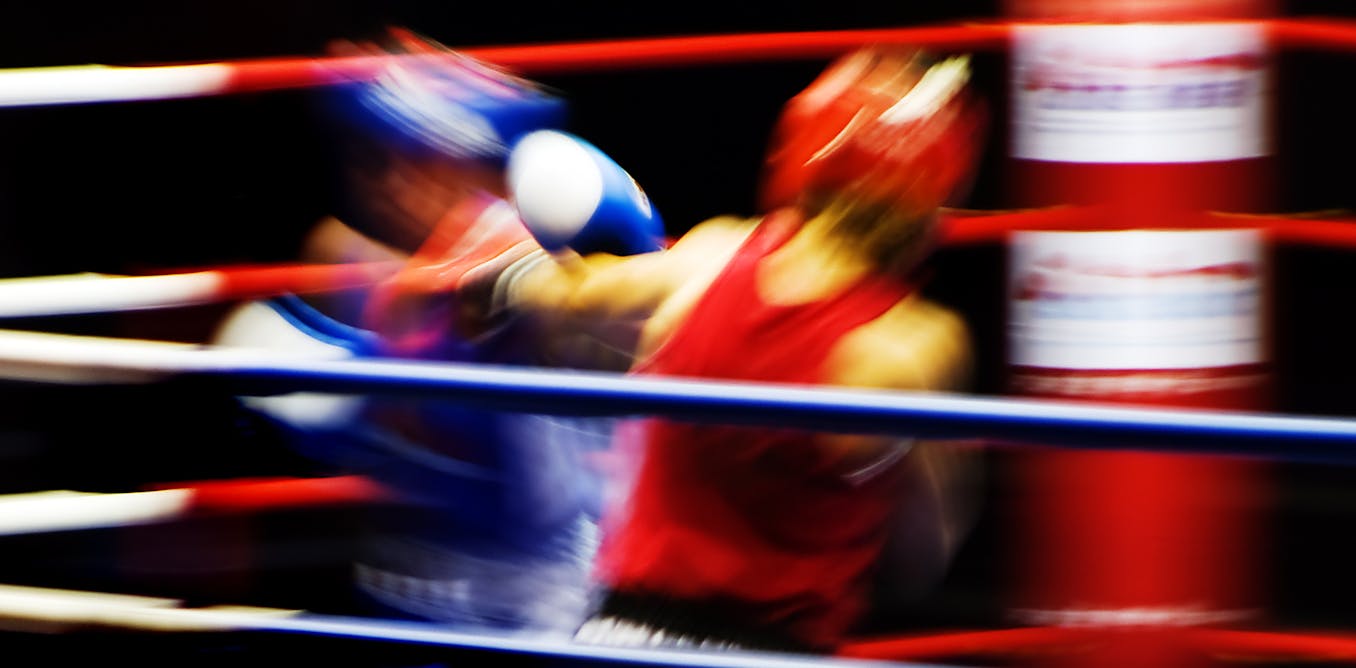
- Select a language for the TTS:
- UK English Female
- UK English Male
- US English Female
- US English Male
- Australian Female
- Australian Male
- Language selected: (auto detect) - EN
Play all audios:
Thrilling the masses for millennia, boxing has evolved down the centuries – rules have changed, equipment improved, training enhanced. However, one key aspect has essentially stayed the
same: incapacitating the opponent before they incapacitate you. Boxers are mostly exposed to subconcussive head impacts, that is, impacts that do not result in visible symptoms of
concussion, much like heading the ball in football. But for many years, debate has raged around the safety of boxing, often focusing on the heavy blows inflicted during competitive fights.
But we decided to look at these subconcussive impacts inflicted during training – or sparring – sessions. Boxing, football and rugby are of particular interest to our work because athletes
are routinely exposed to repetitive subconcussive head impacts, both in training and competition. We have previously shown that a single soccer heading drill affects how the brain “talks” to
the muscles. Sparring sessions – where boxers trade light blows in protective headgear – are well suited for research because they often form part of an athlete’s training regime, and are
fairly easy to replicate in a controlled laboratory environment, which is really important if you want to understand cause and effect. Our latest research is one of the first studies to show
that routine impact in sport – often thought to be fairly harmless – results in measurable changes in the brain. BOXING AND BRAIN FUNCTION By the late 1920s scientists suspected that
repetitive head impacts were associated with damage to the brain. Research from 1928 describes “punch drunk” syndrome, where boxers appeared to stagger around as if under the influence of
alcohol. Scientists noted that the first symptoms of this “dementia pugilistica” – or what we now refer to as Chronic Traumatic Encephalopathy (CTE), was an impairment in brain-to-muscle
communication. CTE is a neurodegenerative disease with Alzheimer’s-like symptoms, characterised by structural, behavioural and cognitive changes in the brain. Since the 1920s, knowledge of
this disease has expanded, but this does not necessarily mean it is fully understood. For example, it is now believed that CTE can be caused by a combination of concussive and subconcussive
injuries (rather than only concussive ones). Yet, not all athletes exposed to concussion/subconcussion develop CTE, meaning that other factors – such as genetics or the environment – have to
play a role. SHORT TERM CHANGES IN THE BRAIN We recruited 20 boxers and Muay Thai athletes, plus 20 healthy individuals who would not receive any blows to the head. All participants
completed tests before and after a 3x3 minute sparring session for boxers and Muay Thai athletes, or a 3x3 minute mock-sparring session where participants only hit pads with boxing gloves.
The tests completed ranged from measures of how well the brain communicates commands to the muscles (done by zapping the brain with a magnetic stimulator and seeing what happens in the
muscle), to tasks designed to test participants’ memory. We found that, much like heading a ball in football, the results of those engaged in the sparring session demonstrated increased
inhibitory mechanisms within the central nervous system. The human body needs a balance of excitatory and inhibitory mechanisms to function properly. If we pretend the brain is a busy
junction with a traffic light, green (excitation) allows information to flow from one part of the body to the other; red (inhibition) ensures that this information moves in a safe and
controlled manner. One hour after sparring, participants showed impaired brain-to-muscle communications and decreased memory performance. Because normal brain chemistry was (temporarily)
disrupted by these subconcussive impacts during the session, the information going from the brain to the muscles slowed down, affecting how they worked, and it was more difficult for
participants to remember things. After 24 hours, these effects returned to normal. WHAT DO THESE RESULTS MEAN? Increased inhibition in the brain is also seen following a concussion and in
this case is thought to be a protective mechanism, slowing down the brain’s processes to prevent further injury and help recovery. Problems may arise if this safeguarding response is
activated without any actual injury (such as following subconcussive head impacts), as it could create a toxic environment and ultimately damage brain cells. Also, if communication between
brain and muscles is not occurring as it should, individuals may be at greater risk of muscular injury because muscles are not being properly controlled by the brain. We already know that
athletes returning to play after a concussion are more likely to sustain an injury. Ultimately, our studies are the first steps in lifting the veil on what goes on the brain after routine
impact in sport. We show that sparring (as we did with heading a ball) results in acute and temporary changes to brain performance. This may be an indication of circuit dysfunction, an
important mechanism in understanding the link between brain impact, brain health and disease. We need to better understand how circuit dysfunction affects the brain when there is repeated
exposure to subconcussive impacts over the course of a sporting career.



